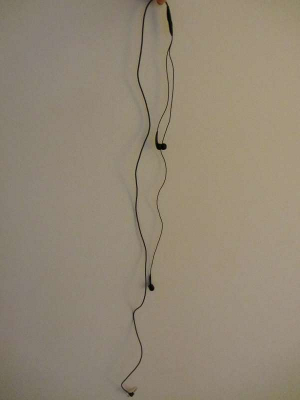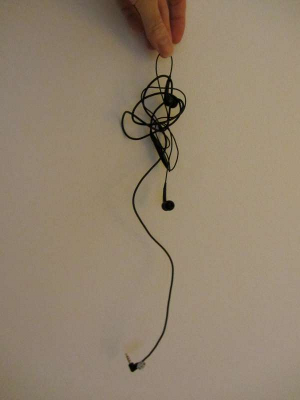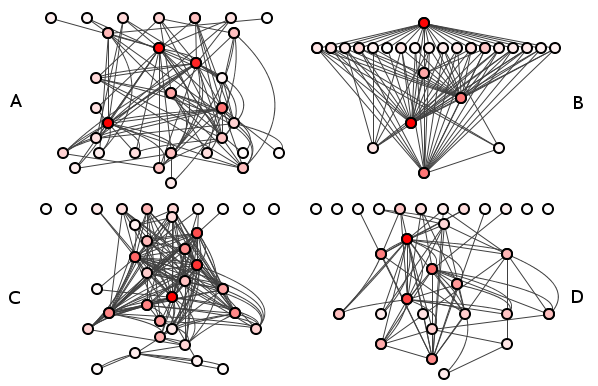The most important factor in software decay
Do you have big balls of mud?
Here’s an experiment to amaze your friends.
You probably listen to music on your phone via some sort of headset. The headset we shall consider here consists of two earbuds (in-ear pieces, rather than head-phones which cover the ears) connected via wires to a jack which plugs into the phone itself. Disconnect your headset from your phone. Show it to your friends. Figure 1 shows a typical example of such a headset.

As you hold the headset wires twixt thumb and finger, shake them about until your friends are bored to tears. Note that the wires may temporarily become tangled with one another but invariably return to the untangled state of figure 1. Now, carefully fold the headset into your trouser pocket and take a long walk, dragging a friend with you to witness that you do not touch the headset further. Finally, return to your friends and carefully extract the headset from your trouser pocket.
TA-DA!!
The wires will have mysteriously collapsed into a tangled disordered mess of kinks, knots and twists of the most bewildering complexity and inventiveness – all without your ever having touched them! Figure 2 shows a sorry headset fished from a trouser pocket.

Don’t tell anyone, but here’s the secret …
Why does this happen? Why don’t the wires remain untangled?
To answer this, we must look at the three actors that take to the stage in both scenarios, scenarios hereafter named the, “Out-of-pocket,” and the, “In-pocket,” scenarios.
First is thermal fluctuation. This refers to the shaking of the headset, both explicitly by jiggling it up and down in the out-of-pocket scenario, and by the slower action of the stride in the in-pocket scenario. Both mechanisms subject the headset to pulses of energy causing its parts to move at random.
Second is gravity. Gravity tends to pull all parts of the headset down and as the jack and earbuds reside at the wire ends (and as the headset is held roughly half-way along its length in figure 1) then the earbuds and jack tend to position themselves towards the bottom of figure 1.
Third is spatial extension. Perhaps the greatest difference between the two scenarios is size of arena in which they operate. In the out-of-pocket scenario, the holding aloft of the headset allows gravity to stretch the headset wires to great extent. Knot-formation relies on two sections of wire coming into contact. Such contacts become simply less probable with increasing volume. In the confined space of the in-pocket scenario, with wire pressed on wire, knots become far more likely.
(Friction also plays a role, with wind resistance easily overcome by gravity in the out-of-pocket scenario but with the cloth-on-cloth surface resistance of the in-pocket scenario holding wires in contact for longer than might otherwise occur, again increasing the probability of knotting.)
Thus, consider the headset in the out-of-pocket scenario. Tugging on the headset will cause it to move, introducing several new bends and twists in the wires. Throughout, however, gravity constantly pulls the earbuds and wires downwards from the point at which they are held, so that as the energy of tug dissipates gravity will already have begun ironing out the loose bends.
In the in-pocket scenario, however, each stride will deliver a weak energy impulse to the headset, enough to move the headset around just a tiny amount. Confined within the pocket volume and unsupported at any point from above, the wires do not stretch out under the influence of gravity but may even pool at the pocket’s bottom, where they will writhe over one another, producing optimal knot-formation conditions.
Despite the tediousness of such a description, we can view these events from another perspective: the perspective of microstate versus macrostate. Now things become a little more interesting.
Microstate and macrostate.
We can think of a, “Microstate,” of the headset not, as might be expected, the state of a small part of the headset, but rather as its complete configuration: a precise description, at a single instant, of the position of its earbuds, jack, and of the entire length and disposition of its wires.
In contrast to this detail, a, “Macrostate,” is a broad and undetailed description of the headset. For reasons that shall be explained in a moment, the, “Order,” of the headset interests us most – that is, how messy and tangled it appears – and hence we shall use the least amount of information possible to describe this order. We shall use the single bit of information – yes or no – that answers the question, “Does this headset look ordered?”
We can say that from an initial microstate of the headset, A, only a certain set of microstates lies thermally accessible in that such microstates deviate from A to a degree allowable by the upcoming energy impulse. Given the randomness of this energy impulse, there is an equal probability of entering any one of those accessible microstates; let us say that the system happens to transition from microstate A to microstate B.
For the out-of-pocket scenario, gravity constantly tries to pull the headset back from microstate B to microstate A (or something like it), so the set of thermally accessible microstates available from microstate B will be slightly biased because gravity will prevent the system reaching states as far from B as B is from A. For the in-pocket scenario, however, once the headset arrives in microstate B then the new set of accessible microstates will contain equal numbers of microstates that move back towards A as away from it. And given that the choice of the new microstate is random, then the in-pocket scenario will allow the headset to enter more microstates inaccessible to the out-of-pocket scenario.
Imagine for a moment that you could count all the microstates in which the headset could find itself, that is, you could take a snap-shot of every possible position that the headset wires could assume. If we focus on just one wire, we might say that the wire looks ordered when it forms a straight line: it contains 0 bends. It still looks ordered with 1 bend, or perhaps 2, or 100. But above a certain number of bends it begins to look disordered. This simply accords with a casual understanding of that term. Yet how many bends can a wire support? Perhaps thousands. Or tens of thousands. Or millions. The point is that the vast majority of microstates of the wire will be what we call, “Disordered,” and only a tiny proportion will be, “Ordered.”
Thus it is not that there are fewer ways to make a disordered headset when it is held aloft than when it sits in a pocket, but that putting a headset in a pocket allows it to randomly explore a far larger number of its available microstates and as the vast majority of these microstates correspond to the disordered macrostate then the in-pocket headset is overwhelmingly likely to end up disordered.
What on earth has this got to do with software?
Software structure, too, exhibits this microstate/macrostate duality. The package structure of a Java program reveals packages connected to other packages by dependencies. This structure at any given time represents one microstate of the system. Programmers add features and make updates, acting as random thermal fluctuations, changing the package structure slightly, nudging the system into new microstates.
(Programmers do not, of course, make random updates to a code-base in that they do not pick a text character at random from the source code and flip it. Nevertheless, no one can predict accurately in advance a year’s worth of updates in any significant code-base. It is in this sense – in this unpredictability and essential patternlessness – that the programmer’s coding can be modeled as a random input to the program.)
Pulling back from the detail of the individual microstates, we evaluate the macrostate of the system by asking, “Does this program look ordered?” If ordered, we say the program is, “Well structured;” otherwise it is, “Poorly structured.” Small programs, with few inter-package dependencies, usually appear ordered. As programs grow, however, there seems inevitably to come a point when dependencies between packages become dense, overstretched and start looping back on themselves: such package structures truly merit the description, “Disordered.”
Brian Foote and Joseph Yoder memorably labeled any such disordered system a Big Ball of Mud, claiming, “A big ball of mud is haphazardly structured, sprawling, sloppy, duct-tape and bailing wire, spaghetti code jungle.” They also claimed big balls of mud to be the de-facto software structure rather than the exception and our headset musings show why this may be so. With Java packages free to depend on one another without restriction, there are far more ways to produce a disordered set of inter-dependent packages than an ordered set of those same packages, so given the thermal fluctuation of programmer input the program will find itself propelled into a series of randomly selected microstates and as most microstates correspond to a disordered macrostate then most systems will end up disordered.
Figure 3 shows the package structures of four programs depicted as four spoiklin diagrams in which each circle represents a package, each straight line a dependency from a package above to below and each curved line a dependency from a package below to above. Despite the rather miniaturized graphics, most programmers would consider only one of these programs to be well-structured.

All of which would remain a mere aesthetic curiosity except for one crucial point: the structure of a program bears directly on the predictability of update costs and often on the actual costs themselves.
Well-structured programs clearly show which packages use the services provided by other packages, thus simplifying prediction of the costs involved in any particular package change. Poorly structured programs, on the other hand, suffocate beneath such choking dependencies that even identifying the impacted packages that might stem from a particular change becomes a chore, clouding cost predictability and often causing that cost to grow disproportionately large.
In figure 3, program B was designed using radial encapsulation, which allows package dependencies only in the direction of the top level package. Such a restriction mirrors the holding aloft of a headset, allowing gravity to stretch it out and keep it spontaneously ordered. Such a restriction makes the forming of a big ball of mud as improbable as a headset held aloft suddenly collapsing into a sequence of knots. The precise mechanism, however, is unimportant. What matters is that the program was designed according to systemic principles that aggressively restrict the number of microstates into which the program might wander whilst ensuring that those inhabitable microstates correspond to an ordered, well-structured macrostate.
No one designs poorly structured programs to be poorly structured. Instead, programs become poorly structured because the structuring principles according to which they are built do not prevent them from becoming so.
Perhaps programmers should ask not, “Why are big balls of mud the de-facto program structure?” but, “Why are good structuring principles ignored?”
Summary
Some find words like, “Thermodynamics,” “Equilibrium,” and, “Entropy,” intimidating so posts exploring these concepts should delay their introduction.
| Reference: | The most important factor in software decay from our JCG partner Edmund Kirwan at the A blog about software. blog. |




